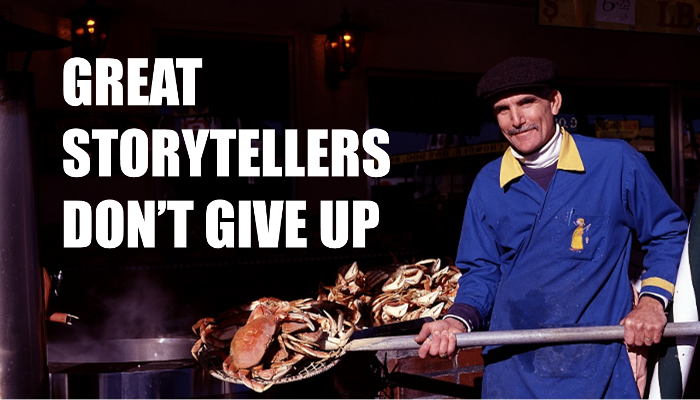
Sometimes a story just doesn’t work. No matter how hard we try, it just doesn’t resonate with an audience. It falls flat and we feel deflated. The question, therefore, is: “What do we do with that feeling?”
![]()
The Discovery Channel’s, Deadliest Catch is a reality television show about crab fishing in the Bering Sea. It’s the story of brave crews that taunt nature’s elements to catch their legal quota of crab within a small “season.” Captains, using a combination of GPS technology and intuition, determine where to drop “strings” of 800-pound baited crab traps called “pots,” which lie on the ocean floor waiting for crabs to crawl into them. After several hours of “soaking,” the crab boats circle back and retrieved the pots.
The show’s producers use the first pot of each string as a dramatic plot point (StoryHow PitchDeck Card #19) for two reasons: its contents usually predicts the success of the string and therefore, it also sets the crew’s morale. If the pot is full of crab, the crew is elated and they don’t mind “grinding” for twenty-four hours to retrieve the packed crab pots. If the first pot is empty, though, morale plummets as the crew realizes that they must spend the next day pulling up empty pots. Empty pots pay nothing and mean more time on the dangerous Bering Sea.
Many similarities exist between crab fishing and business storytelling. Sometimes customers flock to our stories and sometimes they don’t. Since writing a story is hard work, it’s easy for our morale to wane, to question our choices, defend them to upper management, and perhaps even doubt our abilities.
It’s at times like these that we need to learn from the fishing crews of the Cornelia Marie, Northwestern, Time Bandit, and Wizard. Just because one particular presentation, blog post, podcast episode, or video doesn’t resonate with our audience, we can’t stop fishing. Just as crab boat crews re-bait and return their pots to the ocean floor, we must continue to punch those keyboards, speak into those microphones, and look into those video cameras. Just as the crab boat captains learn from each set-and-retrieve cycle, so must we. Our job is to learn something with each story we write so that we can apply it to our next story.
Storytelling is hard work. The trick is to keep on fishing. Great storytellers don’t give up.
Photo Credit:
Highsmith, Carol M, photographer. Employee cracks and steams crabs at Fisherman’s Grotto No. 9 at Fisherman’s Wharf, San Francisco, California. [Between 1980 and 2006] Image. Retrieved from the Library of Congress.